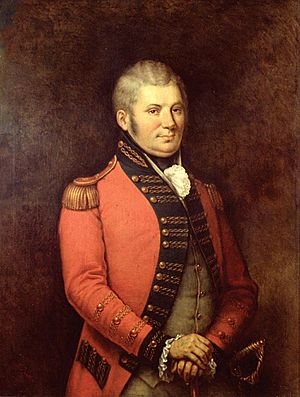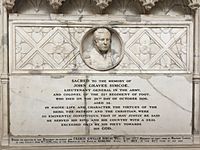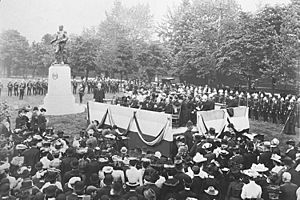John Graves Simcoe facts for kids
Quick facts for kids
John Graves Simcoe
|
|
|---|---|

Portrait by George Theodore Berthon
|
|
| 1st Lieutenant Governor of Upper Canada | |
| In office 1791–1796 |
|
| Monarch | George III |
| Governor General | Gen. Sir Guy Carleton, 1st Baron Dorchester |
| Premier | William Pitt the Younger |
| Preceded by | None |
| Succeeded by | Peter Russell |
| Personal details | |
| Born | 25 February 1752 Cotterstock, Oundle, England |
| Died | 26 October 1806 (aged 54) Exeter, England |
| Spouse | |
| Children | 11 |
| Parents | Captain John Simcoe Katherine Simcoe |
| Education | Eton College, Merton College, Oxford |
| Occupation | Military officer, Colonial administrator |
| Signature | |
| Military service | |
| Allegiance | |
| Branch/service | |
| Years of service | 1770–1806 |
| Rank | Lieutenant-General |
| Unit | 35th Regiment of Foot 40th Regiment of Foot |
| Commands | Queen's Rangers 22nd Regiment of Foot Commander-in-Chief, India |
| Battles/wars | |
John Graves Simcoe (born February 25, 1752 – died October 26, 1806) was a British Army general. He became the first lieutenant governor of Upper Canada from 1791 to 1796. This area is now southern Ontario in Canada.
Simcoe helped found York, which is known today as Toronto. He also played a big part in setting up important things like courts, trial by jury, and English common law. He also worked to end slavery in Canada.
His main goal was to make Upper Canada a strong community. He wanted it to be based on British ideas, showing they were better than the American system. Many Canadians, especially in Southern Ontario, see him as a key figure in their history. Toronto celebrates him with Simcoe Day.
Contents
Early Life and Education
John Graves Simcoe was the only son of John and Katherine Simcoe to live past childhood. His father was a captain in the Royal Navy. He died when John was young, during a war. After his father's death, John's family moved to Exeter, England.
Simcoe went to Exeter Grammar School and Eton College. He also studied at Merton College, Oxford. He decided to follow a military career, just as his father had planned for him.
Military Service in America
In 1770, Simcoe joined the British Army. He was sent to the Thirteen Colonies (which later became the United States). He fought in the American Revolutionary War, including the Siege of Boston.
In 1776, he became a captain. He fought in major battles like the Battle of Brandywine, where he was injured.
Leading the Queen's Rangers
In 1777, Simcoe became the leader of the Queen's Rangers. This was a special unit of well-trained soldiers. They were very active during the war. Simcoe planned a successful surprise attack at the Battle of Crooked Billet.
In 1778, Simcoe and his Queen's Rangers were involved in a conflict at Judge William Hancock's house. Later that year, they fought in the Battle of Monmouth.
Simcoe also led an attack in what is now the Bronx, New York. This area is known as Indian Field in Van Cortlandt Park.
In 1779, Simcoe led a raid in central New Jersey. During this raid, he was captured but later released. He then rejoined his unit in Virginia. He was part of the Raid on Richmond and the Siege of Yorktown. He returned to England in 1781.
After the war, Simcoe wrote a book about his experiences with the Queen's Rangers. It was published in 1787.
Marriage and Family Life
After the war, Simcoe met Elizabeth Posthuma Gwillim. They married in 1782. Elizabeth was very wealthy. She owned a large estate in England called Wolford Lodge. This estate remained the Simcoe family home for many years.
The Simcoes had five daughters before moving to Canada. Their son, Francis, was born in 1791. Sadly, their Canadian-born daughter, Katherine, died as a baby in York (now Toronto). Francis later joined the army and died in battle in 1812.
Entering Politics
Simcoe became involved in politics in 1790. He was elected as a Member of Parliament for St Mawes in England. He supported the government led by William Pitt the Younger.
Instead of leading an invasion of Spain, as he had suggested, he was chosen for a new role. He became the lieutenant governor of the new province of Upper Canada. He left Parliament in 1792 to take on this important job.
Governor of Upper Canada
The Constitutional Act 1791 divided Canada into two parts: Upper Canada (which is now Ontario) and Lower Canada (which is now Quebec). Each province got its own government and elected assembly. Upper Canada was mostly English-speaking. Many settlers were Loyalists who had moved from the Thirteen Colonies after the American Revolutionary War.
Simcoe was appointed Lieutenant-Governor on September 12, 1791. He traveled to Canada with his wife Elizabeth and their daughter Sophia. They arrived in Canada in November but spent the winter in Quebec City due to bad weather. Simcoe finally reached Kingston, Upper Canada, on June 24, 1792.
In 1792, he renamed several islands in the St. Lawrence River after British generals.
Setting Up the Government
The government of Upper Canada included the Lieutenant-Governor, an appointed council, and an elected assembly. The first meeting of this new government happened in Newark (now Niagara-on-the-Lake) on September 17, 1792.
Ending Slavery in Upper Canada
Simcoe was very important in the passing of the Act Against Slavery in 1793. This was the first law in the British Empire to limit slavery. It made it illegal to bring new slaves into Upper Canada. It also said that children born to enslaved mothers would become free when they turned 25.
This law did not free all enslaved people right away. However, it was a big step towards ending slavery. Slavery was completely abolished across the entire British Empire in 1834.
Relations with Indigenous Peoples and the United States
Simcoe was concerned about the conflict between the United States and a group of Native American tribes known as the "Western Confederacy." He hoped to create a neutral area between the US and Canada.
However, the French Revolutionary Wars started in Europe. Britain decided to improve its relationship with the United States. Simcoe was told to avoid upsetting the US but also to keep Native Americans friendly to Britain. Britain eventually provided some weapons to the Native Americans.
In 1794, the governor general, Lord Dorchester, thought war might break out between the US and Britain. He told Simcoe to prepare and arm British ships on the Great Lakes. Simcoe also built Fort Miami to help the Native Americans.
Choosing a New Capital
Simcoe realized that Newark was not a good capital because it was too close to the US border. He wanted to move the capital to a safer place. He suggested a location he named London, with a river he called the Thames.
Lord Dorchester did not agree with London but accepted Simcoe's second choice: the current site of Toronto. Simcoe moved the capital there in 1793. He renamed the settlement York after Frederick, Duke of York, the son of King George III. Simcoe brought many people to help build the new town.
Building Roads
Simcoe started building two important roads in Upper Canada. These roads were for defense, and to help people settle and trade.
- Yonge Street was named after Sir George Yonge. It ran north from York to Lake Simcoe.
- Dundas Street was named after Henry Dundas, 1st Viscount Melville. It ran east to west between York and London.
The conflict between the US and the Native Americans ended with the Treaty of Greenville. Britain also signed the Jay Treaty with the US in 1794. This treaty meant Britain had to leave its forts south of the Great Lakes. Simcoe then moved British troops out of these forts.
Later Career and Legacy

In 1794, Simcoe was promoted to major-general. In July 1796, he became ill and had to return to Britain. He was unable to go back to Upper Canada and resigned from his position in 1798.
Simcoe briefly commanded British forces in Saint-Domingue (now Haiti) from 1796 to 1797. This French colony was in the middle of a slave rebellion. Simcoe was later replaced as commander.
He was promoted to lieutenant-general and given command of the Western District in Britain. In 1806, he was chosen to be the Commander-in-Chief, India. However, he died in Exeter, England, before he could take on this new role.
Simcoe was buried in Wolford Chapel on his family's estate in England. The Ontario Heritage Foundation now owns the chapel.
You can see some of Simcoe's personal items, like his sword, at the Archives of Ontario in Toronto. His wife Elizabeth's paintings are also there.


Many places in Canada are named to honor John Graves Simcoe:
- The town of Simcoe in southwestern Ontario.
- Lake Simcoe and Simcoe County in Ontario.
- Civic Holiday, a public holiday in Canada, is known as Simcoe Day in Toronto. This holiday was established in his honor.
- Governor Simcoe Secondary School in St. Catharines, Ontario.
- Three streets in downtown Toronto: John Street, Graves Street (now Duncan Street), and Simcoe Street.
- Simcoe Island, near Kingston, Ontario.
- Simcoe Hall at the University of Toronto.
- John Graves Simcoe Armoury in Aurora, Ontario.
- Governors Road, a section of Ontario Highway 99.
See also
 In Spanish: John Graves Simcoe para niños
In Spanish: John Graves Simcoe para niños

